Compact Open-Path Sensor for Fast Measurements of CO2 and H2O using Scanned-Wavelength Modulation Spectroscopy with 1f-Phase Method
Abstract
1. Introduction
2. Materials and Methods
2.1. Instrument Design
2.2. Spectroscopy Methodology
3. Results and Discussion
3.1. Instrument Performance
3.2. Calibration and Measurement Precision
3.3. Comparison and Field Measurements
4. Conclusions
Author Contributions
Funding
Conflicts of Interest
References
- Tans, P.P.; Bakwin, P.S.; Guenther, D.W. A feasible Global Carbon Cycle Observing System: A plan to decipher today’s carbon cycle based on observations. Glob. Chang. Boil. 1996, 2, 309–318. [Google Scholar] [CrossRef]
- Takahashi, T.; Sutherland, S.C.; Sweeney, C.; Poisson, A.; Metzl, N.; Tilbrook, B.; Bates, N.; Wanninkhof, R.; Feely, R.A.; Sabine, C.; et al. Global sea–air CO2 flux based on climatological surface ocean pCO2, and seasonal biological and temperature effects. Deep. Sea Res. Part II Top. Stud. Oceanogr. 2002, 49, 1601–1622. [Google Scholar] [CrossRef]
- Pachauri, R.K.; Meyer, L.A. (Eds.) Climate Change 2014: Synthesis Report. Contribution of Working Groups I, II and III to the Fifth Assessment Report of the Intergovernmental Panel on Climate Change; IPCC: Geneva, Switzerland, 2014; 151p. [Google Scholar]
- Muller-Karger, F.E.; Varela, R.; Thunell, R.; Luerssen, R.; Hu, C.; Walsh, J.J. The importance of continental margins in the global carbon cycle. Geophys. Res. Lett. 2005, 32. [Google Scholar] [CrossRef]
- Pachauri, R.K.; Reisinger, A. (Eds.) Climate Change 2007: Synthesis Report; Intergovernmental Panel on Climate Change: Cambridge, UK, 2007. [Google Scholar]
- Crawford, T.L.; Mcmillen, R.T.; Meyers, T.P. Spatial and temporal variability of heat, water vapor, carbon dioxide, and momentum air-sea exchange in a coastal environment. J. Geophys. Res. 1993, 98, 12869–12880. [Google Scholar] [CrossRef]
- Edson, J.B.; Fairall, C.W.; Mestayer, P.G.; Larsen, S.E. A study of the inertial-dissipation method for computing air-sea fluxes. J. Geophys. Res. Space Phys. 1991, 96, 10689. [Google Scholar] [CrossRef]
- Hendriks, D.M.D.; Dolman, H.; Van Der Molen, M.; Van Huissteden, J. A compact and stable eddy covariance set-up for methane measurements using off-axis integrated cavity output spectroscopy. Atmos. Chem. Phys. Discuss. 2008, 8, 431–443. [Google Scholar] [CrossRef]
- Takahashi, T.; Sutherland, S.C.; Wanninkhof, R.; Sweeney, C.; Feely, R.A.; Chipman, D.W.; Hales, B.; Friederich, G.; Chavez, F.; Sabine, C.; et al. Climatological mean and decadal change in surface ocean pCO2, and net sea–air CO2 flux over the global oceans. Deep. Sea Res. Part II: Top. Stud. Oceanogr. 2009, 56, 554–577. [Google Scholar] [CrossRef]
- Prytherch, J.; Yelland, M.; Pascal, R.W.; Moat, B.I.; Skjelvan, I.; Neill, C.C. Direct measurements of the CO2flux over the ocean: Development of a novel method. Geophys. Res. Lett. 2010, 37, 12. [Google Scholar] [CrossRef]
- Baldocchi, D. Measuring fluxes of trace gases and energy between ecosystems and the atmosphere—The state and future of the eddy covariance method. Glob. Chang. Biol. 2014, 20, 3600–3609. [Google Scholar] [CrossRef]
- Honkanen, M.; Laakso, L.; Tuovinen, J.P. Measuring turbulent CO2 fluxes with a closed-path gas analyzer in a marine environment. Atmos. Meas. Tech. 2018, 11, 5335–5350. [Google Scholar] [CrossRef]
- Roobaert, A.; Laruelle, G.G.; Landschützer, P. The spatiotemporal dynamics of the sources and sinks of CO2 in the global coastal ocean. Glob. Biogeochem. Cycles 2019, 33. [Google Scholar] [CrossRef]
- Fennel, K.; Alin, S.; Barbero, L.; Evans, W.; Bourgeois, T.; Cooley, S.; Dunne, J.; Feely, R.A.; Hernandez-Ayon, J.M.; Hu, X.; et al. Carbon cycling in the North American coastal ocean: A synthesis. Biogeosciences 2019, 16, 1281–1304. [Google Scholar] [CrossRef]
- Jones, E.P.; Smith, S.D. A first measurement of sea-air CO2 flux by eddy correlation. J. Geophys. Res. 1977, 82. [Google Scholar] [CrossRef]
- Brach, E.J.; Desjardins, R.L.; Amour, G.T.S. Open path CO2 analyzer. J. Phys. E 1981, 14, 1415–1419. [Google Scholar] [CrossRef]
- Ohtaki, E.; Matsui, T. Infrared device for simultaneous measurement of fluctuations of atmospheric carbon dioxide and water vapor. Bound.-Layer Meteorol. 1982, 24, 109–119. [Google Scholar] [CrossRef]
- He, Y.; Jin, C.; Kan, R.; Liu, J.; Liu, W.; Hill, J.; Jamie, I.; Orr, B.J. Remote open-path cavity-ringdown spectroscopic sensing of trace gases in air, based on distributed passive sensors linked by km-long optical fibers. Opt. Express 2014, 22, 13170–13189. [Google Scholar] [CrossRef] [PubMed]
- O’Keefe, A.; Scherer, J.J.; Paul, J.B. cw Integrated cavity output spectroscopy. Chem. Phys. Lett. 1999, 307, 343–349. [Google Scholar] [CrossRef]
- Zahniser, M.S.; Nelson, D.D.; McManus, B.; Kebabian, P.L.; Lloyd, D.; McManus, J.B. Measurement of trace gas fluxes using tunable diode laser spectroscopy. Philos. Trans. R. Soc. London. Ser. A Phys. Eng. Sci. 1995, 351, 371–382. [Google Scholar]
- Rowe, M.; Fairall, C.W.; Perlinger, J.A. Chemical sensor resolution requirements for near-surface measurements of turbulent fluxes. Atmos. Chem. Phys. Discuss. 2011, 11, 5263–5275. [Google Scholar] [CrossRef]
- Li, H.; Rieker, G.B.; Liu, X. Extension of wavelength-modulation spectroscopy to large modulation depth for diode laser absorption measurements in high-pressure gases. Appl. Opt. 2006, 45, 1052–1061. [Google Scholar] [CrossRef]
- Rieker, G.B.; Jeffries, J.B.; Hanson, R.K. Calibration-free wavelength-modulation spectroscopy for measurements of gas temperature and concentration in harsh environments. Appl. Opt. 2009, 48, 5546–5560. [Google Scholar] [CrossRef] [PubMed]
- Mei, L.; Svanberg, S. Wavelength modulation spectroscopy-digital detection of gas absorption harmonics based on Fourier analysis. Appl. Opt. 2015, 54, 2234–2243. [Google Scholar] [CrossRef] [PubMed]
- Strand, C.L. Scanned Wavelength Modulation Absorption Spectroscopy with Application to Hypersonic Impulse Flow Facilities. Ph.D. Thesis, Stanford University, Stanford, CA, USA, 2014. [Google Scholar]
- Goldenstein, C.S.; Almodóvar Christopher, A.; Jeffries, J.B. High-bandwidth scanned-wavelength-modulation spectroscopy sensors for temperature and H2O in a rotating detonation engine. Meas. Sci. Technol. 2014, 25, 105104. [Google Scholar] [CrossRef]
- Wang, Z.; Fu, P.; Chao, X. Laser Absorption Sensing Systems: Challenges, Modeling, and Design Optimization. Appl. Sci. 2019, 9, 2723. [Google Scholar] [CrossRef]
- Yang, C.; Mei, L.; Kan, R. Wavelength modulation spectroscopy by employing the first harmonic phase angle method. Opt. Express 2019, 27, 12137–12146. [Google Scholar] [CrossRef] [PubMed]
- Yang, C.; Mei, L.; Wang, X.P.; He, Y.B.; Kan, R.F. Simultaneous measurement of gas absorption and path length by employing the first harmonic phase angle method in wavelength modulation spectroscopy. Opt. Express 2020, 28, 3289–3297. [Google Scholar] [CrossRef]
- Peng, W.Y.; Strand, C.L.; Hanson, R.K. Analysis of laser absorption gas sensors employing scanned-wavelength modulation spectroscopy with 1f-phase detection. Appl. Phys. B Opt. Lasers 2019. [Google Scholar] [CrossRef]
- Herriott, D.R.; Schulte, H.J. Folded Optical Delay Lines. Appl. Opt. 1965, 4, 883–889. [Google Scholar] [CrossRef]
- Goldenstein, C.S.; Schultz, I.A.; Spearrin, R.M.; Hanson, R.K. Scanned-wavelength-modulation spectroscopy near 2.5 µm for H2O and temperature in a hydrocarbon-fueled scramjet combustor. Appl. Phys. B Opt. Lasers 2014, 116, 717–727. [Google Scholar] [CrossRef]
- Zhou, Y.Z. Development of a Single-Ended Laser-Absorption Spectroscopy Sensor for High-Temperature Gases. Ph.D. Thesis, Purdue University, West Lafayette, IN, USA, 2018. [Google Scholar]
- Werle, P.; Šlemr, F. The limits of signal averaging in atmospheric trace-gas monitoring by tunable diode-laser absorption spectroscopy (TDLAS). Appl. Phys. A 1993, 57, 131–139. [Google Scholar] [CrossRef]
- LI-COR, Inc. LI-7500RS Open-Path CO2/H2O Gas Analyzer Instruction Manual; LI-COR Biosciences: Lincoln, NE, USA, 2019. [Google Scholar]
- Kaimal, J.C.; Wyngaard, J.C.; Izumi, Y.; Coté, O.R. Spectral characteristics of surface-layer turbulence. Q. J. R. Meteorol. Soc. 1972, 98, 563–589. [Google Scholar] [CrossRef]
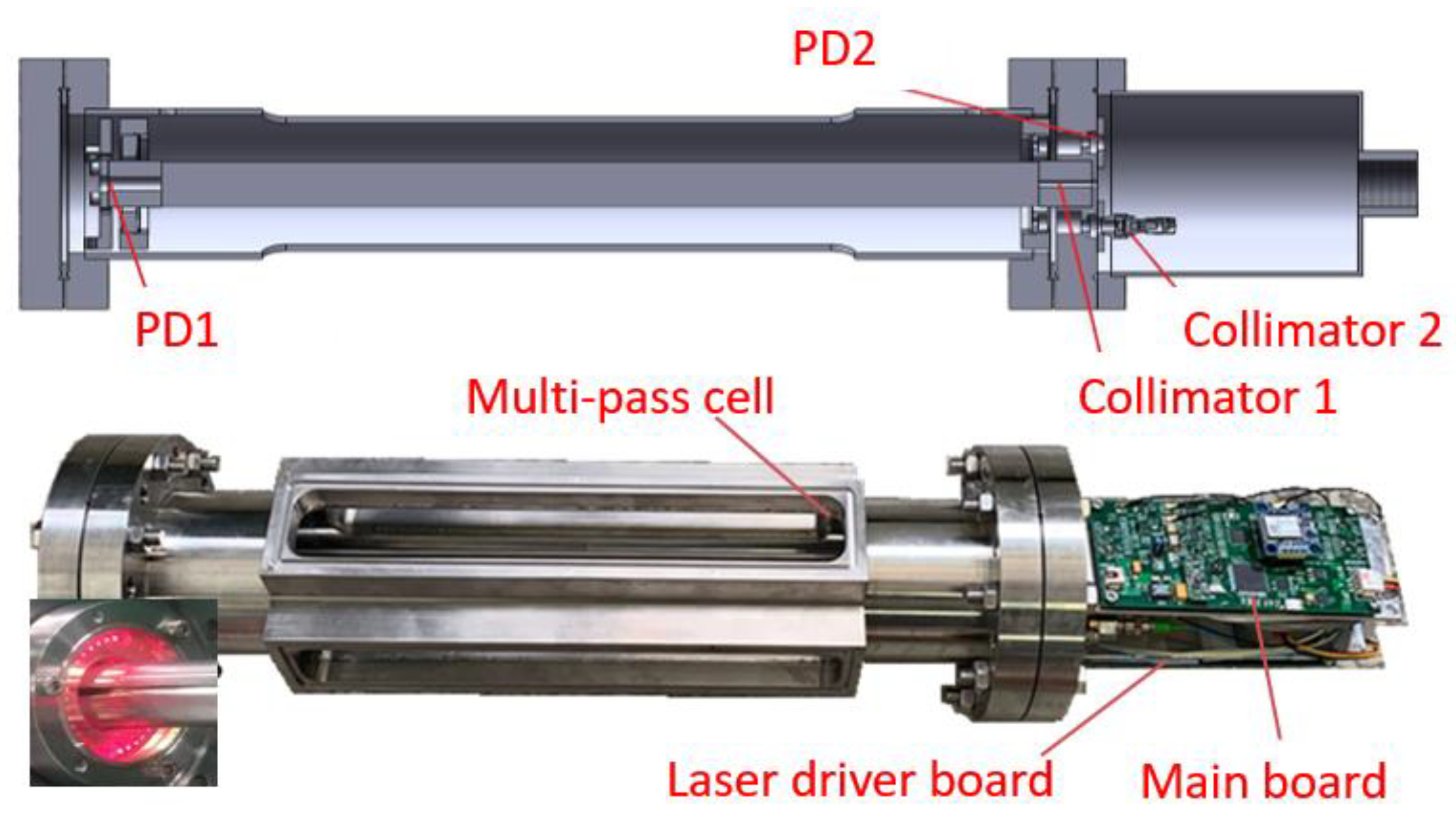


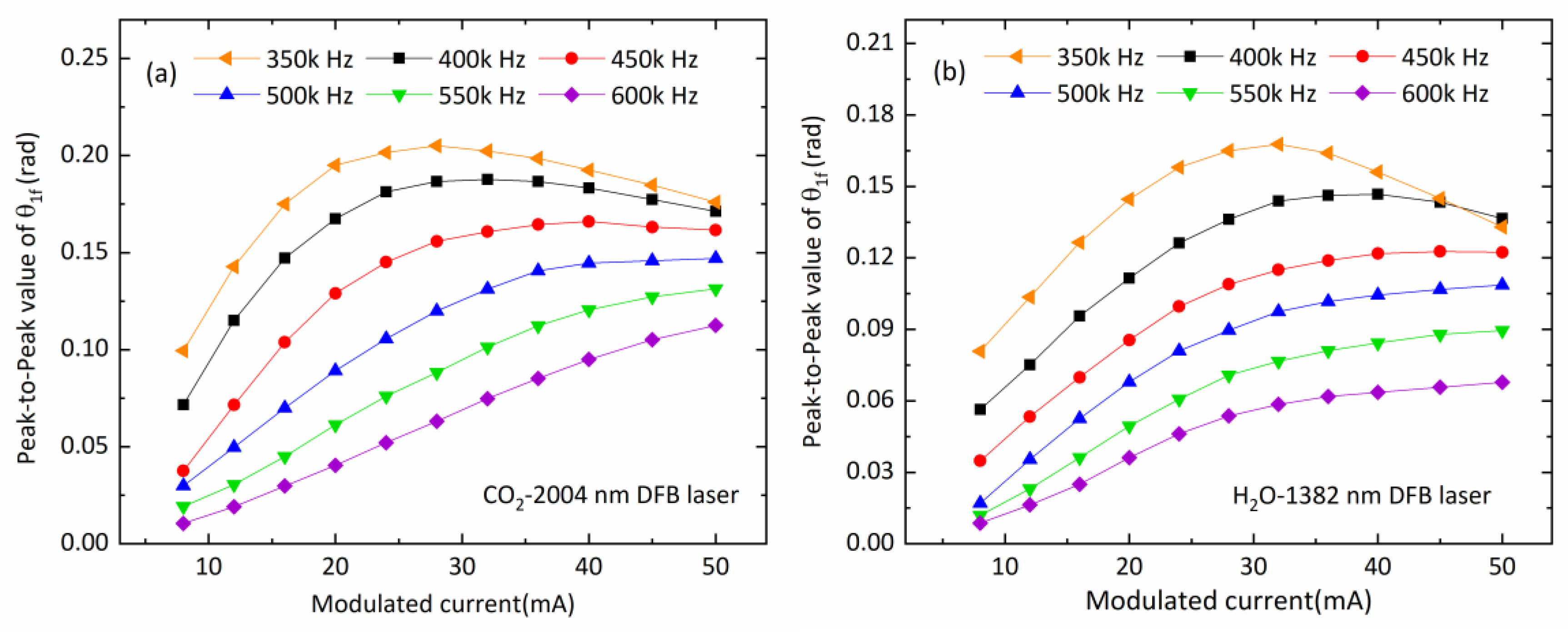
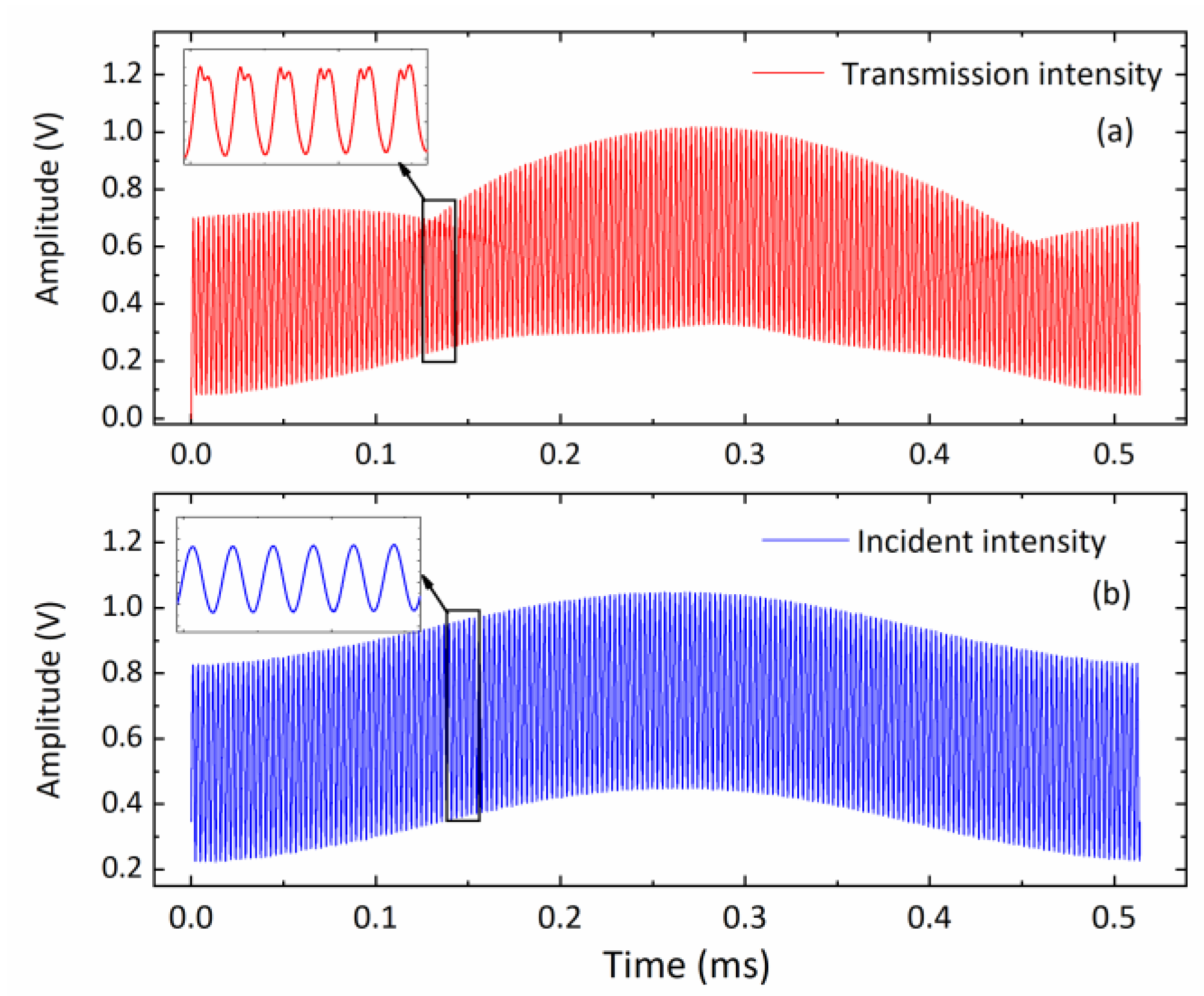


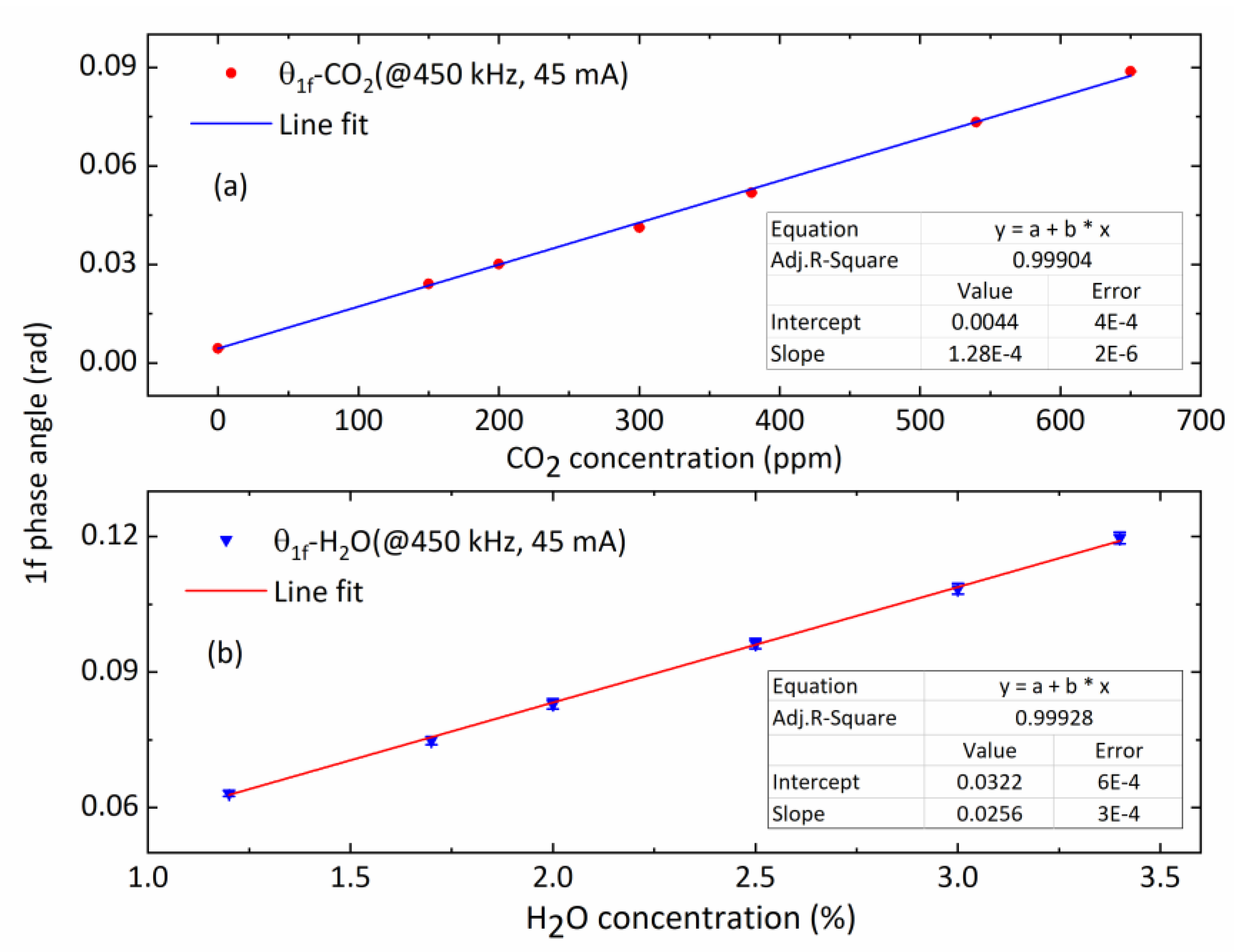


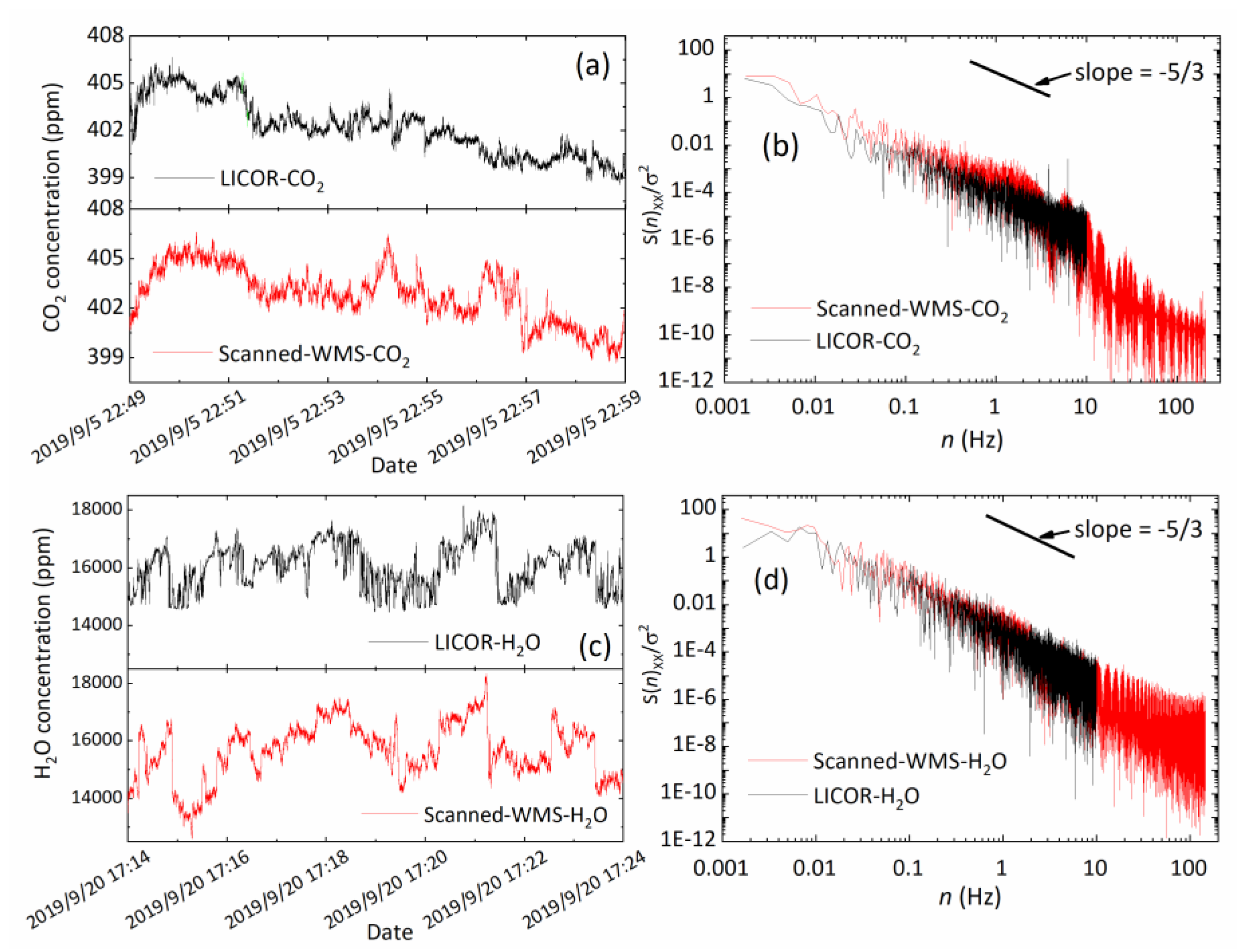
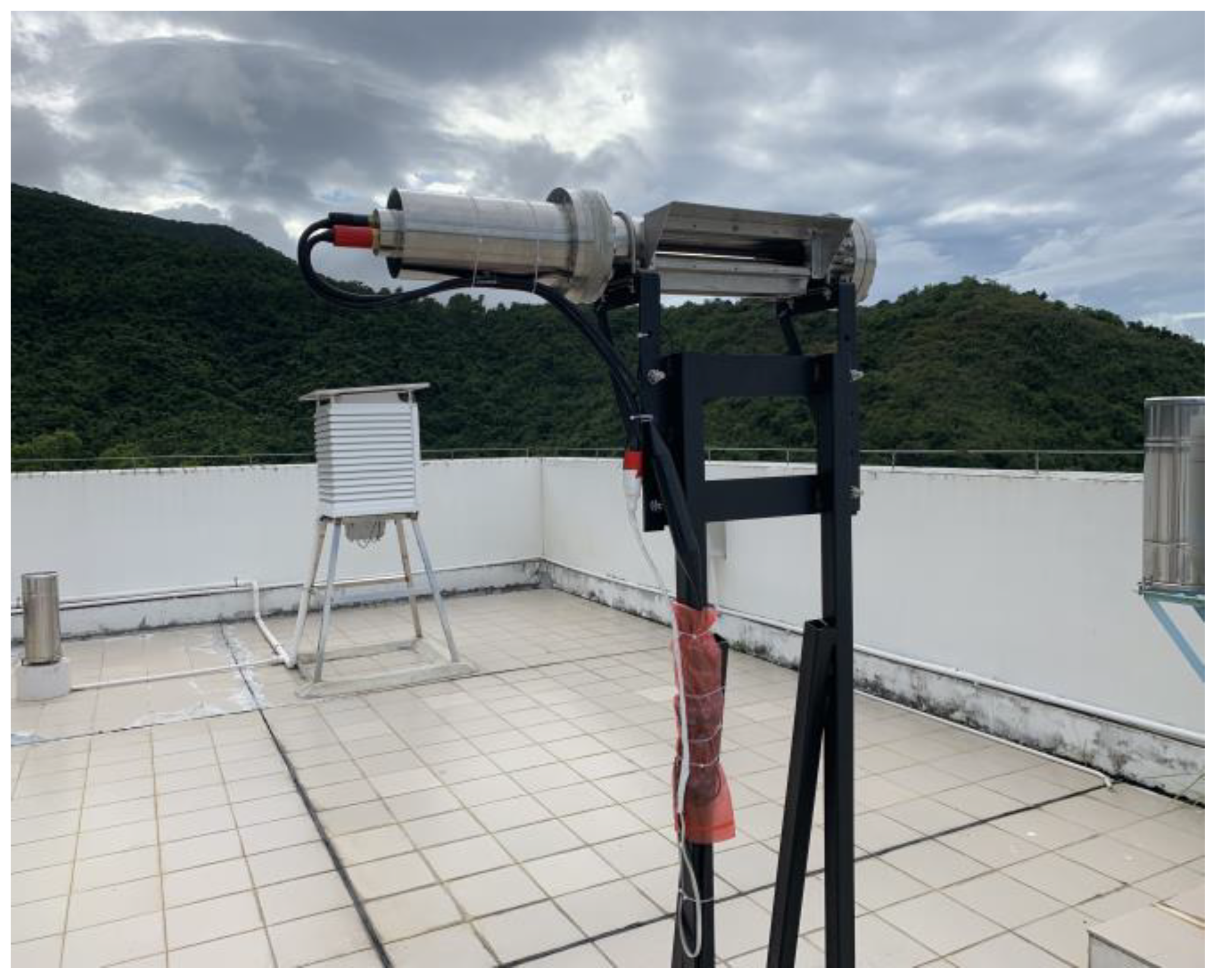
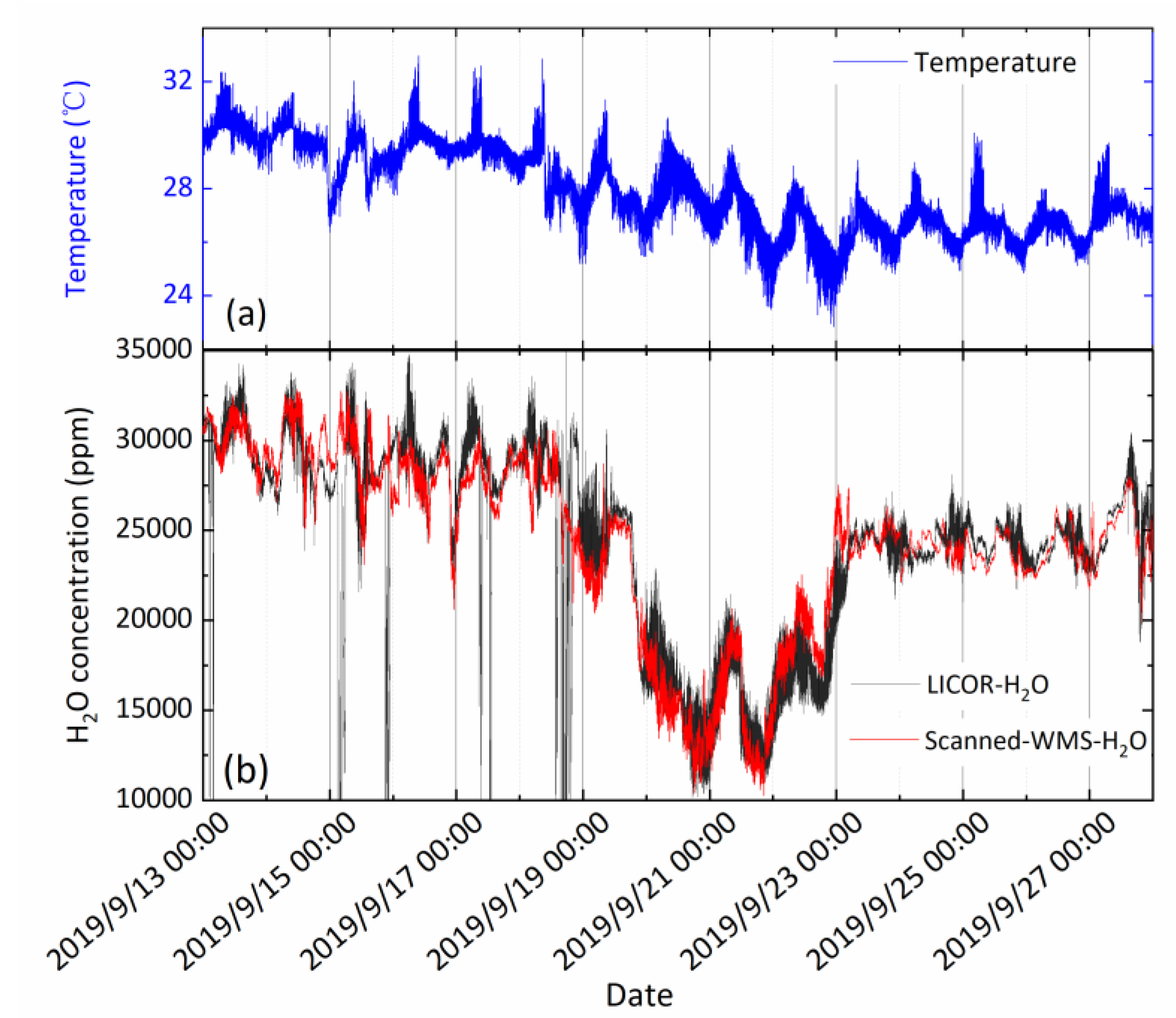
© 2020 by the authors. Licensee MDPI, Basel, Switzerland. This article is an open access article distributed under the terms and conditions of the Creative Commons Attribution (CC BY) license (http://creativecommons.org/licenses/by/4.0/).
Share and Cite
Li, X.; Yuan, F.; Hu, M.; Chen, B.; He, Y.; Yang, C.; Shi, L.; Kan, R. Compact Open-Path Sensor for Fast Measurements of CO2 and H2O using Scanned-Wavelength Modulation Spectroscopy with 1f-Phase Method. Sensors 2020, 20, 1910. https://doi.org/10.3390/s20071910
Li X, Yuan F, Hu M, Chen B, He Y, Yang C, Shi L, Kan R. Compact Open-Path Sensor for Fast Measurements of CO2 and H2O using Scanned-Wavelength Modulation Spectroscopy with 1f-Phase Method. Sensors. 2020; 20(7):1910. https://doi.org/10.3390/s20071910
Chicago/Turabian StyleLi, Xiang, Feng Yuan, Mai Hu, Bin Chen, Yabai He, Chenguang Yang, Lifang Shi, and Ruifeng Kan. 2020. "Compact Open-Path Sensor for Fast Measurements of CO2 and H2O using Scanned-Wavelength Modulation Spectroscopy with 1f-Phase Method" Sensors 20, no. 7: 1910. https://doi.org/10.3390/s20071910
APA StyleLi, X., Yuan, F., Hu, M., Chen, B., He, Y., Yang, C., Shi, L., & Kan, R. (2020). Compact Open-Path Sensor for Fast Measurements of CO2 and H2O using Scanned-Wavelength Modulation Spectroscopy with 1f-Phase Method. Sensors, 20(7), 1910. https://doi.org/10.3390/s20071910




